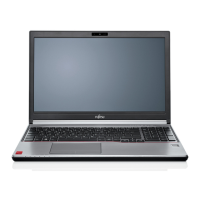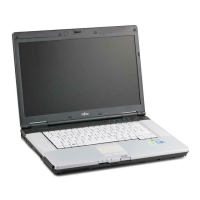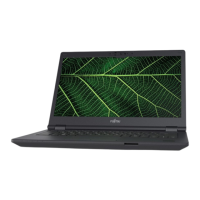How to correct the date or time on Fujitsu Laptop?
- AAlyssa AdamsSep 12, 2025
You can set the date and time in the main menu using the BIOS-Setup-Utility.

How to correct the date or time on Fujitsu Laptop?
You can set the date and time in the main menu using the BIOS-Setup-Utility.
What to do if external monitor remains blank with Fujitsu Laptop?
If your external monitor remains blank, first ensure it is switched on. Check if power saving mode is activated by pressing any key. Adjust the monitor's brightness if it's set too low. Verify that the screen output is correctly set and that the power and data cables are properly connected to both the notebook and the external monitor. Turn off the external monitor and the notebook. Check whether the power cable is plugged properly into the external monitor and into the power socket. Check whether the data cable is properly connected to the notebook and the external monitor. Switch on the external monitor and the notebook.
How to fix the LCD screen when it is difficult to read on Fujitsu LIFEBOOK E459?
If the LCD screen is hard to read on your Fujitsu Laptop, try turning the notebook or adjusting the tilt of the screen to reduce reflected glare. You can also increase the screen's brightness.
How to fix external monitor when it is blank or the image is unstable on Fujitsu LIFEBOOK E459?
If the external monitor is blank or the image is unstable, stop the application program under Windows by pressing Alt + F4. If the error persists after stopping the program, use the key for switching screen output to switch to the LCD screen of the notebook. Change the following setting: Set the screen resolution as described in the documentation for your operating system. Select monitor: Select monitor 1 or 2 as described in the documentation for your operating system.
How to fix Fujitsu LIFEBOOK E459 keyboard when only numerals are written?
If only numerals appear when typing characters on your Fujitsu Laptop, the virtual numeric keypad is likely activated. Press the Num key to deactivate it.
How to fix Fujitsu LIFEBOOK E459 Laptop keyboard controller error?
To fix this error, switch off the notebook using the ON/OFF button. Wait 3-5 seconds, and then switch the notebook back on.
What does Failure Fixed Disk n error mean on Fujitsu Laptop?
The settings of the hard disk drive are incorrect. Start the BIOS Setup (Primary Master submenu) and select the correct settings.
What does CMOS battery bad error mean on Fujitsu LIFEBOOK E459 Laptop?
If the error message occurs repeatedly, the buffer battery in the notebook is flat.
How to fix Fujitsu LIFEBOOK E459 when operating system not found?
Check in the BIOS Setup whether your hard disk has been set correctly. Make sure that the operating system is installed on the corresponding drive.
What does it mean: System CMOS checksum bad - default configuration used on Fujitsu LIFEBOOK E459 Laptop?
The system configuration information is incorrect. To resolve this, switch the notebook off, then on again. Press the F2 key to access the BIOS Setup. In the BIOS Setup, select the Exit menu, then select 'Load Setup Defaults', and press Enter.
Details on drivers and software available online, plus OS compatibility notes.
Explanation of symbols and text formatting used in the manual for clarity.
Identifies and describes ports and indicators on the front of the LIFEBOOK E449.
Details ports located on the left and right edges of the LIFEBOOK E449.
Illustrates and explains components on the underside of the LIFEBOOK E449.
Identifies and describes ports and indicators on the front of the LIFEBOOK E459.
Details ports located on the left and right edges of the LIFEBOOK E459.
Illustrates and explains components on the underside of the LIFEBOOK E459.
Essential safety information to follow when operating the notebook.
Specific safety guidelines for using wireless features like WLAN and Bluetooth.
Tips for conserving power and reducing environmental impact.
Recommendations for safely transporting the notebook during travel.
Instructions for safely cleaning the notebook's exterior and screen.
Steps for unpacking and checking the notebook for any shipping damage.
Guidance on choosing a suitable and safe environment for setting up the notebook.
Instructions for correctly connecting the power adapter to the notebook and outlet.
Procedure for the first time powering on the notebook and starting the setup.
Explanation of system status lights and how to switch the notebook on/off.
Details on the keyboard, numeric keypad, function keys, and key combinations.
Using the touchpad for navigation and input, plus LCD screen characteristics.
Using the webcam and connecting audio peripherals like speakers and microphones.
Guidance on caring for, charging, and replacing the notebook's rechargeable battery.
Utilizing power-saving features and connecting to networks via wireless or LAN.
Configuring the fingerprint reader for biometric authentication.
How to attach and use a physical security lock to prevent theft.
Setting supervisor and user passwords for BIOS access and system security.
Enabling password protection to prevent unauthorized OS startup.
Securing the hard disk drive with a password.
Enabling or disabling the TPM for enhanced hardware security features.
Connecting external displays via VGA, DisplayPort, and HDMI.
Information on connecting various USB peripherals and their data transfer rates.
Using the USB Type-C port for charging external devices.
Utilizing the USB port to charge devices even when the notebook is off.
Connecting headsets, headphones, and microphones to the audio jack.
Steps to take before removing or installing internal hardware components.
Procedure for safely opening and closing the notebook's casing.
Detailed steps for adding or replacing RAM modules.
Instructions for installing or removing M.2 storage devices.
Steps for replacing or installing a hard disk drive.
Completing component replacement and preparing the device for operation.
How to access the system's BIOS setup menu.
Using keys to move through menus and change settings within the BIOS.
Options for saving or discarding changes and exiting the BIOS utility.
Procedure to follow when encountering a fault or error message.
Guide for reinstalling the operating system and recovering data.
Solutions for date/time errors, keyboard input problems, and display issues.
Steps to fix issues with external displays not showing an image.
Solutions for network connection failures and printer issues.
Interpreting and resolving error codes displayed during system startup.
Detailed technical specifications for LIFEBOOK E449 and E459 models.
Technical details and types of batteries used in the notebooks.
Information on proper disposal and recycling procedures for notebook batteries.
References to additional certifications and compliance information.











